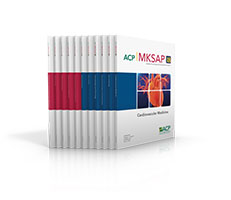 MKSAP has been trusted by internists since 1967 as the best resource for updating knowledge. MKSAP 18, available in Complete, Digital, and Print packages, consists of 11 comprehensive text chapters with related multiple-choice questions. You'll find 1,200 completely new questions to help you identify learning gaps, stay current, and gain the knowledge you need to provide the best possible patient care. MKSAP 18's original and high-quality questions evolve out of case studies and patient scenarios based on the latest evidence.
MKSAP has been trusted by internists since 1967 as the best resource for updating knowledge. MKSAP 18, available in Complete, Digital, and Print packages, consists of 11 comprehensive text chapters with related multiple-choice questions. You'll find 1,200 completely new questions to help you identify learning gaps, stay current, and gain the knowledge you need to provide the best possible patient care. MKSAP 18's original and high-quality questions evolve out of case studies and patient scenarios based on the latest evidence.
For more information on MKSAP 18, or to order your copy, visit mksap18.acponline.org.
MKSAP 18 Q & A
A 22-year-old woman is evaluated in the emergency department after an episode of syncope. She experienced a prodrome of nausea, diaphoresis, and warmth while waiting in line to attend a concert in a crowded, warm corridor. Her boyfriend reports that she recovered quickly and was not confused after the event. Before the episode, she had skipped dinner to arrive at the concert early. She experienced a similar episode of syncope at age 14 years when she had venipuncture for routine laboratory testing. She describes no other symptoms at the time of the episode, and her only reported symptom at this time is fatigue. She takes no medications.
On physical examination, blood pressure is 118/65 mm Hg sitting and 108/60 mm Hg after standing for 3 minutes, and pulse rate is 78/min sitting and 82/min after standing for 3 minutes. Other vital signs and the remainder of the examination are normal.
An electrocardiogram is normal.
Which of the following is the most likely diagnosis?
A: Hypoglycemia-induced syncope
B: Neurally mediated syncope
C: Orthostatic syncope
D: Postural orthostatic tachycardia syndrome

